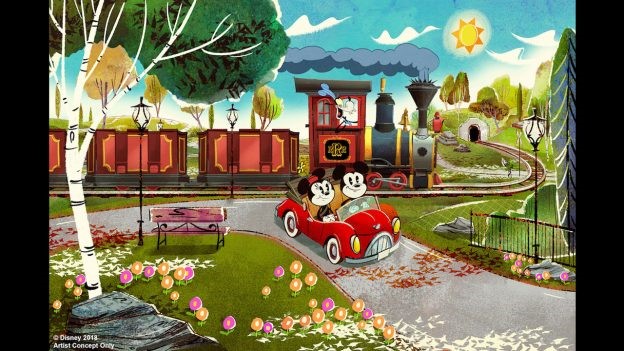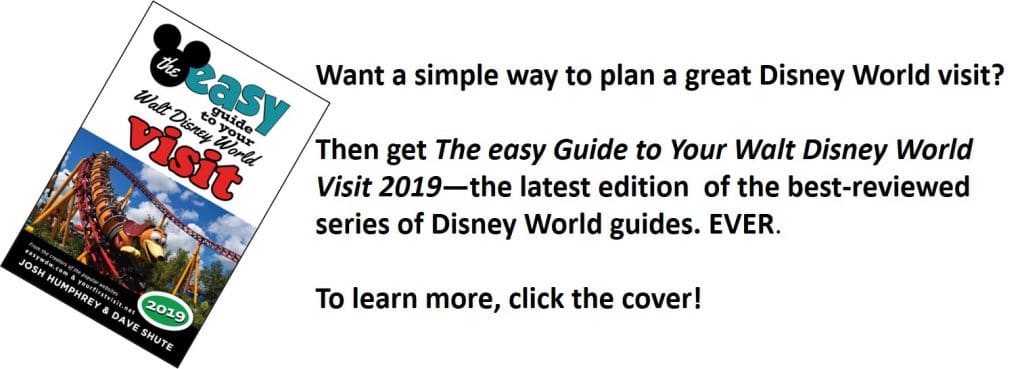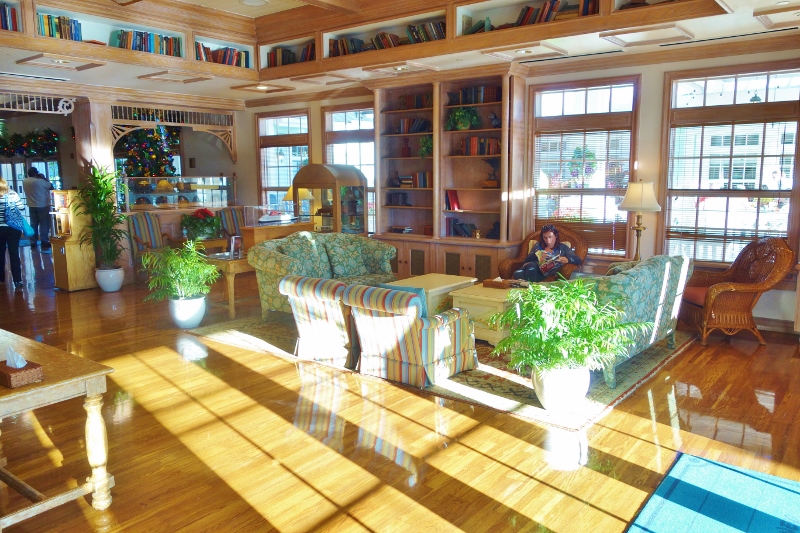Category — A Friday Visit with Jim Korkis
A Friday Visit with Jim Korkis: Mickey and Minnie’s Runaway Railway
Welcome back to Fridays with Jim Korkis! Jim, the dean of Disney historians, writes about Walt Disney World history every Friday on yourfirstvisit.net.
MICKEY AND MINNIE’S RUNWAY RAILWAY AT DISNEY’S HOLLYWOOD STUDIOS
By Jim Korkis
[Update April 2019: The opening of this ride will be delayed until the spring of 2020–Dave]
On July 15, 2017, it was announced that The Great Movie Ride would be closing, to be replaced with a Mickey Mouse-themed attraction, Mickey & Minnie’s Runaway Railway.
Imagineering would work with the creative team at Disney Television Animation (Paul Rudish, Joseph Holt and composer Christopher Willis) that is responsible for the new Mickey Mouse cartoons appearing on The Disney Channel since 2013.
Executive producer and director Paul Rudish said “The immediate inspiration for the new (three and a half minute) Mickey Mouse shorts is — the old Mickey Mouse shorts! The originals were kind of our launching point, to go back to that flavor of Mickey. As long as his personality is intact, Mickey can live and do anything all over the world.”
By the end of Season Five in 2018, the Disney Channel series will total more than 90 shorts, including a special seven-minute extended-length birthday episode airing in late 2018. The twenty-one minute long Duck the Halls: A Mickey Mouse Christmas Special was released in 2016. Chris Diamantopoulos, not Bret Iwan, supplies the voice of Mickey because the producer wanted more of an “edge” to the voice.
For the attraction based on the new Mickey cartoon design and attitude, Imagineer Kevin Rafferty said teams are inventing new technologies that turn the flat world of a colorful cartoon short into a “dimensional display of amazingness” in a process Disney is referring to as “2 ½ D” since no special glasses will be required. Rafferty added, “This is not going to be a small attraction, it’s going to be game-changing.”
Guests enter the Chinese Theater for a premiere of a new Mickey Mouse cartoon short with a new song. In the pre-show, guests see Mickey and Minnie getting ready for a picnic and as they drive out to the location, they pass alongside of a train with Goofy as the engineer.
The attraction puts the guests on that train as they enter the cartoon itself into a “wacky and unpredictable world”. To capture that animation experience, the partners at Disney Television Animation have been supplying much assistance.
Guests will see Mickey and Minnie as full-sized audio-animatronics figures in their car driving alongside the train. A maquette of the classic duo in the car can be seen at the preview of the attraction currently at Walt Disney Presents.
Suddenly guests find themselves in the middle of a stampede followed by a trip to a carnival that ends in being caught up in a twister.
The whirling wind drops everyone into a tropical locale with a large screen and water effects (since the train cars are teetering near the edge of a waterfall). Those cars flush through a drainage pipe into a big city where there is a dance studio run by an audio-animatronics Daisy Duck, who even gets the cars to dance.
Somehow all of this leads to an alleyway with a large factory where Mickey and Minnie must save the guests from a giant furnace before arriving in the park for a picnic where an audio-animatronics Pluto greets the guests. The guests go out through a movie screen to get to the final exit.
The attraction will utilize the same trackless ride technology as The Great Movie Ride, and include an original musical score as well as a theme song that Imagineers hope guests will find “lovable” and keep humming. It was once hoped that this multi-dimensional experience would open in time for Mickey’s 90th birthday celebration this month but it is now scheduled for 2019.
* * * * *
Thanks, Jim! I’m really looking forward to this ride. The latest rumors seem to point to a “Fall 2019” opening, but I’m hoping for the summer! Update April 2019: The opening of this ride will be delayed until the spring of 2020.
And come back next Friday for more from Jim Korkis!
In the meantime, check out his books, including his latest, Secret Stories of Mickey Mouse, and his Secret Stories of Walt Disney World: Things You Never You Never Knew, which reprints much material first written for this site, all published by Theme Park Press.
Follow yourfirstvisit.net on Facebook or Twitter or Pinterest!!
November 2, 2018 3 Comments
A Friday Visit with Jim Korkis: Married to the Mouse
Welcome back to Fridays with Jim Korkis! Jim, the dean of Disney historians, writes about Walt Disney World history every Friday on yourfirstvisit.net.
YOUR PERSONAL DISNEY LIBRARY (10)
By Jim Korkis
- Married to the Mouse by Richard E. Foglesong
While published in 2003, the two hundred page Married to the Mouse is still a popular selling book, and is often referenced in the notes of other books about Walt Disney World. It is clearly in the “academic” category and could easily be used as a text for a class in urban planning, tax codes and similar subjects.
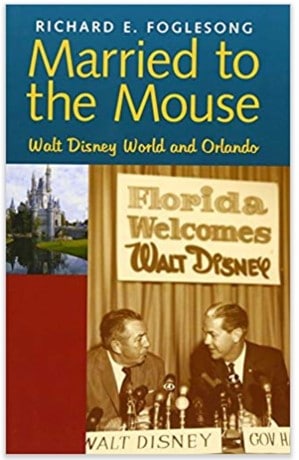
Foglesong feels that Disney “seduced” Florida so that Disney could become a “Vatican with mouse ears”–basically a self-governing city with no outside interference. With progress also comes loss (after all, hundreds of private homes and businesses were demolished for the creation of I-4) but Foglesong feels the scales were tipped strongly in Disney’s favor, even though Orlando did receive many economic benefits.
The book is definitely biased that Disney is the villain and that it received overwhelming privileges through the creation of the Reedy Creek Improvement District by falsely claiming that the company was still intending to build the City of the Tomorrow that Walt Disney had promised before his death. Foglesong feels that Disney maintained a charade of building an E.P.C.O.T. in order to circumvent government restrictions so that they could do whatever they wanted on the property.
In the years that followed, he feels Disney not only used but abused its governmental immunities enabled by officials too timid to challenge what the Mouse wanted to do right from the very beginning. Disney competed for (and won) bond money, which ultimately paid for new sewers to accommodate its own expansion rather than for low-income housing in a county already overwhelmed with Disney workers. When the Orlando Sentinel ran a series offering “tepid” criticism of Disney’s bad-neighbor policy, the paper was banned from being sold at the theme park.
That being said, the book does have some value, especially in the early chapters about the creation of Walt Disney World. I found the later chapters to be a little harder to muddle through the intricacies of the rather dry financial information. The facts are accurate and Foglesong did his own original research including interviews with people like Billy Dial, who was one of the prime movers and shakers in Orlando who helped smooth the way for the building of WDW.
I appreciated that at the back of the book is a nineteen page appendix listing and identifying people who were involved with Walt Disney World, from Roy Hawkins to Tom Moses to Martin Andersen. All of those listed are extremely important to understanding WDW history.
I also appreciated some of the insights that he included, like the fact that one of the major reasons for building Walt Disney World was that Walt wanted to diversify and not be too dependent upon the fickle nature of Hollywood films. He also points out that one of the reasons for the selection of land was not just to distance itself from the distractions of the beach but to allow for a 360 degree expansion in the future.
These thoughts and others do not appear in any other books discussing the building of WDW. Fifteen years have passed since the book first appeared, so it is definitely due for an updating especially in terms of whether anything has been corrected or even greater perils from Disney’s autonomy have arisen.
* * * * *
Thanks, Jim! This was, years ago, one of the first “difficult” books about Disney World that I read. I found the history interesting and Foglesong’s perspectives widened my understanding. Personally I find it more useful as a book that is somewhat inadvertently about negotiating, than as a book about what Disney did “wrong.”
And come back next Friday for more from Jim Korkis!
In the meantime, check out his books, including his latest, Secret Stories of Mickey Mouse, and his Secret Stories of Walt Disney World: Things You Never You Never Knew, which reprints much material first written for this site, all published by Theme Park Press.
Follow yourfirstvisit.net on Facebook or Twitter or Pinterest!!
October 26, 2018 No Comments
A Friday Visit with Jim Korkis: Tom K. Morris on Dreamfinder and Figment
Welcome back to Fridays with Jim Korkis! Jim, the dean of Disney historians, writes about Walt Disney World history every Friday on yourfirstvisit.net.
TOM K. MORRIS ON DREAMFINDER AND FIGMENT
By Jim Korkis
Starting at Disneyland in 1973 as a teenager selling balloons, Tom K. Morris worked for roughly forty-two years at Disney. In 1979, he moved into Imagineering and his first real assignment was working on the original Journey Into Imagination pavilion for Epcot Center.
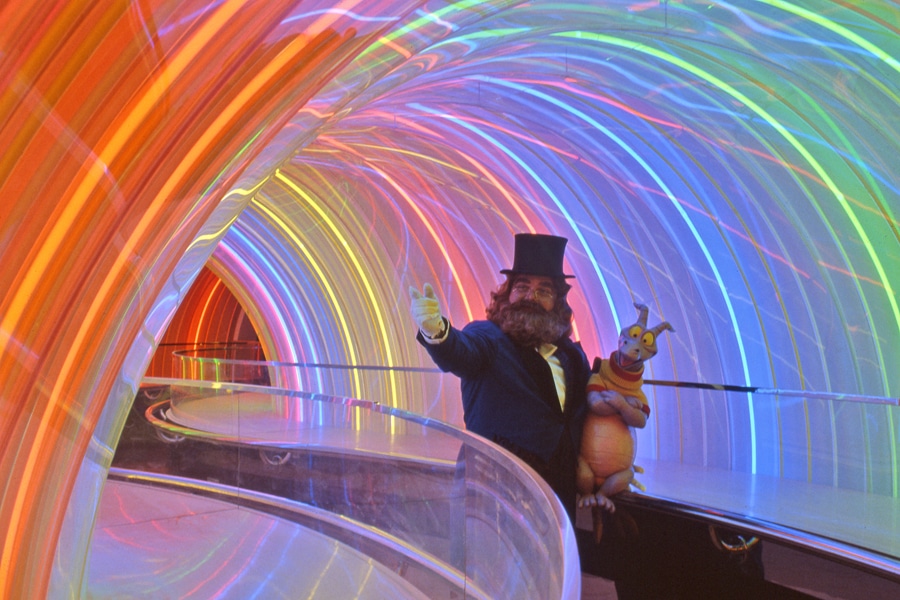
(c) Disney
Morris was involved in dozens of both big and small projects throughout his career and recently retired. I talked with him in December 2017 and here are some secrets of Dreamfinder and Figment that he shared with me.
Imagineer Steve Kirk was the artist who came up with the original physical designs for Dreamfinder and Figment but it was Imagineer X. Atencio who did the final designs.
Morris had originally requested that actor Paul Frees, noted for his many vocal contributions to Disney park attractions (e.g. the auctioneer in Pirates, the Ghost Host in Haunted Mansion), be the voice of Dreamfinder, but was told that Frees was just too expensive for the budget for the project.
WED hired actor Chuck McCann, a showbiz veteran by the age of 17, who performed his nightclub act on popular television shows. He has had a career as a serious actor (The Heart is a Lonely Hunter in 1968), a comic actor (Silent Movie in 1976), an Oliver Hardy impersonator (along with Jim McGeorge in the Stan Laurel role), and as a voice artist in dozens of animated cartoons, including the original syndicated animated series Duck Tales (Duckworth and the Beagle Boys) and many more.
A man of many voices, McCann based the voice of Dreamfinder on actor Frank Morgan’s performance as the Wizard in MGM’s The Wizard of Oz (1939). However, during the recording of the original sessions, there was some dispute (which has never been clearly explained) and McCann left the project.
I asked Morris if he knew the reason and he claimed that he did not but that “there are still people alive today who do know.”
The Imagineers found a “sound alike” in Ron Schneider, who had been an understudy for actor Wally Boag at the Golden Horseshoe Revue in Disneyland. Schneider recorded the remaining lines for the character after intensively studying McCann’s already recorded tracks and was hired to be the first walk-around Dreamfinder character.
Morris also originally requested actor Robin Williams to do the voice of Figment. However, Williams had just finished doing the successful television show, Mork and Mindy, and was infinitely more expensive than Frees. When Morris told me the fees asked by Frees and Williams, they did not seem outrageous for that work, but Disney has always been “cost efficient.”
Actor John Byner was brought in to audition for Figment. At the time he was doing the voice of the anthropomorphic creature known as Gurgi in Disney’s animated feature The Black Cauldron (1985) and did an amusing, high-pitched nonsense, garbled voice. Imagineer Tony Baxter felt it didn’t quite sound childlike enough.
The first official ride through the original attraction of Journey Into Imagination was on December 4, 1982, for Kodak executives who loved it. Morris has a photo of all of them, along with countless other photos (some Polaroids) and slides, some taken backstage, which I hope will find their way into one of the books he is planning to write. He already has contracts with Disney Editions for The Architecture of Disneyland and The Alchemy of Imagineering, or perhaps the photos could be in another book of their own.
* * * * *
Thanks, Jim! And come back next Friday for more from Jim Korkis!
In the meantime, check out his books, including his latest, Secret Stories of Mickey Mouse, and his Secret Stories of Walt Disney World: Things You Never You Never Knew, which reprints much material first written for this site, all published by Theme Park Press.
Follow yourfirstvisit.net on Facebook or Twitter or Pinterest!!
October 19, 2018 No Comments
A Friday Visit with Jim Korkis: Disney’s Old Key West Resort
Welcome back to Fridays with Jim Korkis! Jim, the dean of Disney historians, writes about Walt Disney World history every Friday on yourfirstvisit.net.
DISNEY’S OLD KEY WEST RESORT
By Jim Korkis
In the early 1900s, the only way to get to Key West was by plane, boat or train. It was not accessible by car until many years later. That is why the check-in desk at Disney’s Old Key West Resort resembles a train station–with actual antique lampposts from Key West’s Duval Street.
After a guest passes the security gate, they drive over a bridge to suggest the bridges that have to be crossed to get to each of the fabled island Keys.
Just to the left of the check-in desk is a small lounge called Papa’s Den filled with books on shelves. “Papa” was the nickname of famed author Ernest Hemingway who supposedly wrote part of his novel A Farewell to Arms while living in Key West.
On either side of the fireplace are sets of framed pens, authentic to the early 1900s, to suggest Hemingway’s writing. The marlin fish handing overhead and vintage lures underneath suggest Hemingway’s love of fishing and his famous book The Old Man and the Sea.
Hemingway had a great love for cats, and so there are eight small statues of cats in the den as well. The two lion statues on the shelves reference his love of big game hunting, the bull his interest in bullfighting and running with the bulls. You’ll also find cigar boxes to hold his Cuban cigars and a hand bell to symbolize For Whom the Bell Tolls.
The fictional mayor of the town of Conch Flats is Cooter Trumbo, Esquire. “Cooter” is a call-out to a slang name for a turtle (turtles are a reoccurring theme in the resort) in the southeast United States, and “Trumbo” is for Trumbo Point, a man made addition to Key West in 1912 by the Trumbo American Dredging Company to accommodate a shipping port for the railroad.
The town’s logo includes an image of the city and three Latin phrases: Pro Bono Persona (For Your Own Good), Veni Vici Veni Adinfiintium (I Came. I Saw. I Stayed Forever) and Carpe Diem Omnidiem (Seize the Day Everyday.)
On the upper shelves and rafters of The Conch Flats General Store are items that reflect Old Key West’s history of wrecking and salvaging from nearby shipwrecks, making it the richest city in the United States at one time.
Turtle Krawl, sometimes spelled Kraal or Kraul, is an Afrikaans and Dutch word that refers to a corral for sea turtles that were often gathered in Key West for export and the making of turtle soup that was once considered a delicacy for the elite. In 1971, the United States government banned the killing of Green Sea Turtles, and today turtle soup is made from regular turtles.
That reference to the turtle industry is also in Old Turtle Pond Road and the Turtle Shack at the resort.
There is a lighthouse by the pool that calls to mind the famous Key West lighthouse opened in 1848 to help stop the inhabitants from causing shipwrecks.
Toward the end, the brick road ends and REST Beach begins. Key West, because of its hard coral, had man-made beaches. REST is actually an acronym for Recreation, Exercise, Swimming and Tennis.
The “family tree” just beyond the gigantic sand castle was planted in 1991 and is one tree with multiple trunks springing from it. To the left of it is a similar tree that was planted to show the original height the family tree was in 1991.
For those interested in more stories about Conch Flats, the resort offers a free guided walking tour most Wednesdays and Saturdays.
* * * * *
Thanks, Jim! In the small world department, our home was built as the summer cottage of one of John Rockefeller’s bankers–a man who almost certainly would have known Henry Flagler in his Cleveland days, before he went to Florida and founded the railroad to Old Key West. Perhaps Flagler was even in our house once, long ago!
And come back next Friday for more from Jim Korkis!
In the meantime, check out his books, including his latest, Secret Stories of Mickey Mouse, and his Secret Stories of Walt Disney World: Things You Never You Never Knew, which reprints much material first written for this site, all published by Theme Park Press.
Follow yourfirstvisit.net on Facebook or Twitter or Pinterest!!
October 12, 2018 2 Comments
A Friday Visit with Jim Korkis: The Epcot Space Pavilion
Welcome back to Fridays with Jim Korkis! Jim, the dean of Disney historians, writes about Walt Disney World history every Friday on yourfirstvisit.net.
THE EPCOT SPACE PAVILION THAT NEVER WAS
By Jim Korkis
As we continue the countdown to the opening of Star Wars: Galaxy’s Edge, it’s fun to remember that there were always plans for a Space Pavilion at Epcot. However, despite multiple attempts, Disney was unable to find a sponsor for such a project.
One version, as described by Tad Stones, who worked at Imagineering with Tim Delaney but later found greater success supervising the animated series for the Disney Afternoon block of programming: “Joe Haldeman, the Hugo Award winning science fiction author wrote a script for a pavilion. You’re inside a giant ball that is rotating and the idea was you took a 360-degree theater and turned it vertically so you’re looking up and down as opposed to side to side.
“Down below are audio-animatronics of the crew and robots. The idea is that you go through an excursion through the solar system with characters interacting and providing entertainment as well as knowledge about all of this.
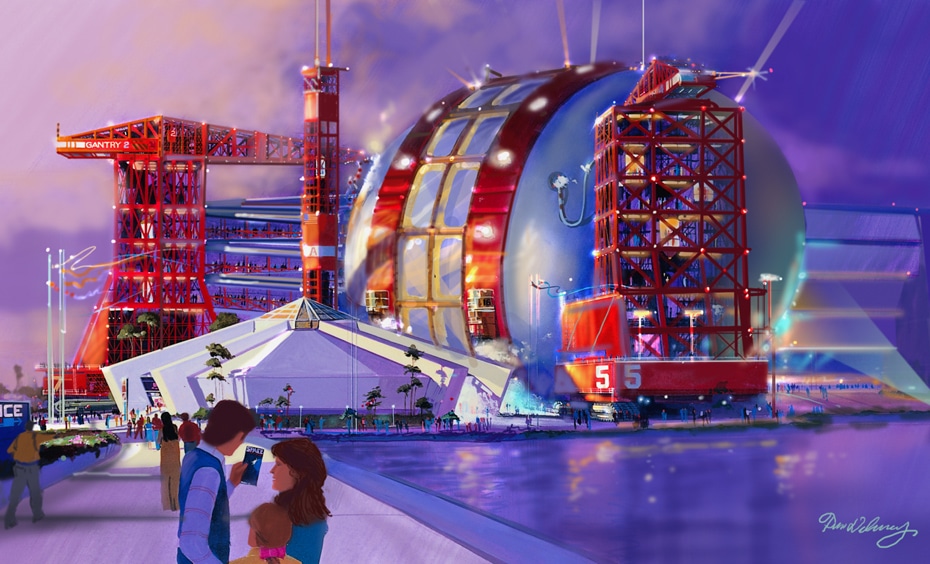
From timjdelaney.com
“We found that it was unnatural to turn the theater vertically because things like looking at a planet now become distorted because of the perspective. You would be on a balcony. It would have been hugely expensive and the show would have lasted eight minutes.”
One of the designs that got as far as a three-dimensional model was the work of Imagineer Larry Gertz. It was a white domed model to simulate a base located on an asteroid orbiting the moon where mining was taking place. It was supposedly a makeshift affair built of a used space station and parts of old space craft.
The “traveler” would arrive aboard a simulated space craft. When the guest steps off the vehicle onto a ramp, he would leave behind the noises of flight behind him and find himself in utter silence.
The ramp would lead the guest to a staging area and from there allow him to enter the base itself.
The four main elements in the dome would be the space station, the asteroid honeycombed with great caverns and mine shafts, an astronaut training thrill ride, and a children’s playscape.
“You’ll be able to wander at will through the asteroid,” Gertz said in the 1980s. “It will be a visceral experience of space. You can follow catwalks through the caves.”
One of the thrill rides would be a simulator. They would represent devices down in a gaping excavation, bobbing and probing into the rock like huge, spidery mining machines.
On the lower level would be the astronaut training facility. It was actually a modified roller coaster where guests would get into a mining car. A catapult would propel the vehicle from a standing stop to sixty miles per hour in four and a half seconds, putting three G’s of pressure on the passengers. The vehicle would rocket three times around the asteroid on tracks.
“We’ve tried to create something that feels like a mining town,” explained Gertz. “We’ve also created something that might resemble the living environment in a space station. There is a general store selling all kinds of space stuff. And we’ve put in a sales lot for used space craft. You’ll see satellite communications in operation too. Lots of education in this.”
The station pavilion would be 300 feet in diameter and 110 feet high. In comparison, Space Mountain at WDW was 200 feet in diameter and 90 feet high.
What stalled this project from developing further was the lack of a corporate sponsor to foot the bill.
* * * * *
Thanks, Jim! I had utterly forgotten about the Space Pavilion idea. And while I grew up on classic science fiction (Asimov, Heinlein, and Clarke), Joe Haldeman’s Forever War series is one of my favorites.
And come back next Friday for more from Jim Korkis!
In the meantime, check out his books, including his latest, Secret Stories of Mickey Mouse, and his Secret Stories of Walt Disney World: Things You Never You Never Knew, which reprints much material first written for this site, all published by Theme Park Press.
Follow yourfirstvisit.net on Facebook or Twitter or Pinterest!!
October 5, 2018 No Comments
A Friday Visit with Jim Korkis: Disney’s Tiki Culture
Welcome back to Fridays with Jim Korkis! Jim, the dean of Disney historians, writes about Walt Disney World history every Friday on yourfirstvisit.net.
TIKI CULTURE AT WALT DISNEY WORLD AND DISNEYLAND
By Jim Korkis
Brandon Kleyla, sometimes known as Trader Brandon, just released a small book entitled The Field Guide to Tiki Decorating, available only directly through him at www.traderbrandon.com.
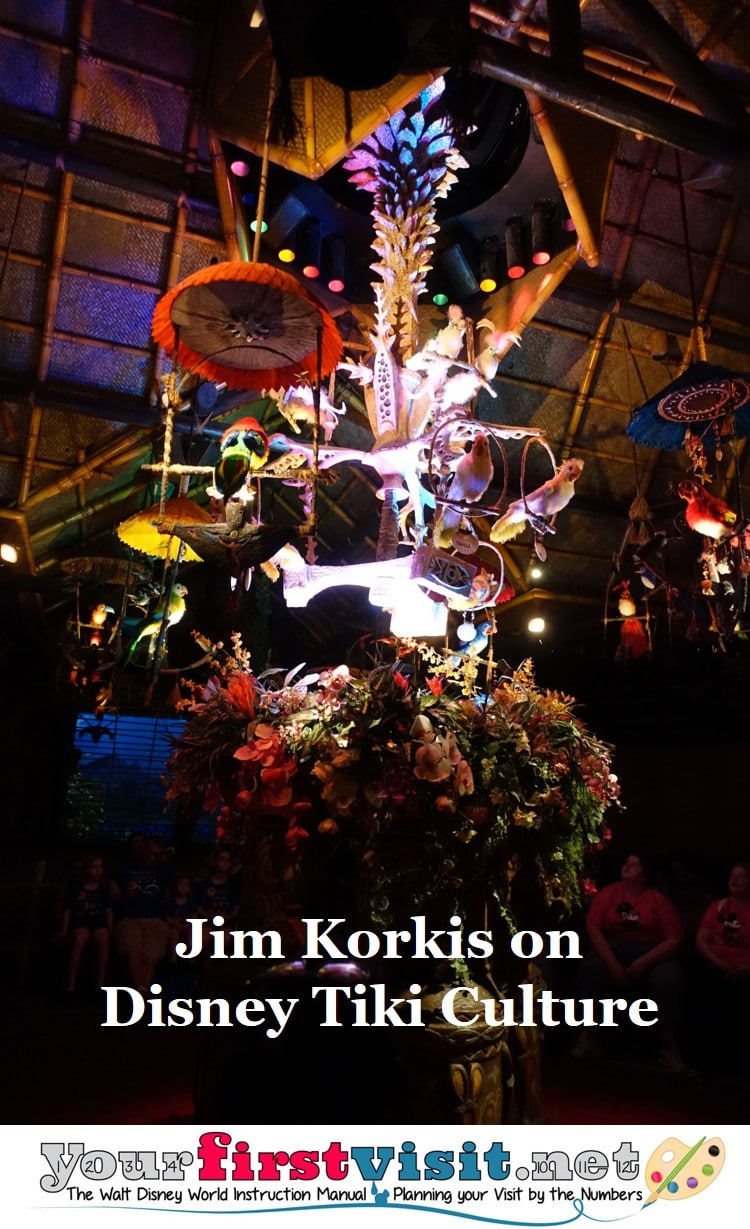
“The book started because people were asking me to write a Trader Sam’s related book which obviously because of Disney trademark restrictions on intellectual property I can’t,” shared Kleyla with writer Seth Kubersky. “But I started putting together thoughts together of what I could share about creating a backstory, music, lighting…kind of a big overview.
“I’m sad because I don’t really enjoy Trader Sam’s as a guest because I’ve slept in there. I’ve lived in there. But I get to enjoy sitting in a corner, just watching everyone else and seeing them react so I get that side of it.”
Disneyland, of course, was partly responsible for the revival of Tiki Culture in the 1960s. Stouffer’s sponsored the Plaza Pavilion and the Tahitian Terrace restaurants at Disneyland and had contracted to sponsor the new “adventure in eating and dining” called The Enchanted Tiki Room which would share the kitchen with those other two dining locations. Posters were printed up and guests alerted.
Reservations (the first ever restaurant at Disneyland to have reservations) were to be spaced at one hour intervals and after the main course had been completed the performing audio-animatronics tropical birds would spring to life in dozens of overhead bird cages.
Walt soon realized that guests would be so enchanted that they stopped eating and didn’t finish in time for the next seating. In addition, the space was so small that it would have limited capacity as a restaurant. (That is certainly the situation with both Trader Sam’s locations, with lengthy wait times for the limited indoor space.)
The Enchanted Tiki Room–where all the birds sing words and the flowers croon– opened June 23, 1963 at Disneyland and it was the first to feature audio-animatronics technology developed by WED (Imagineering) from recently declassified military documents about the launching of rockets and releasing the various stages (open/close the same as bird beaks).
The building was the first fully air-conditioned building at the park, in order to make sure the computers in the basement of the attraction did not overheat. Since the attraction was owned by WED rather than Disneyland, guests paid an extra seventy-five cents (the cost at that time of an “E” Ticket) to experience it.
An almost identical copy of the show (but with a much different pre-show) called Tropical Serenade opened with Walt Disney World in 1971. It was rehabbed as The Enchanted Tiki Room (Under New Management) in 1998. It returned to its original format in August 2011 with a slighted edited version of the original show. [A review is here–Dave.]
Of course, the Polynesian Village Resort that also opened in 1971 has many references to Tiki Culture, including since 2015 Trader Sam’s Grog Grotto located inside the Great Ceremonial House where guests can order a HippopotoMai-Tai in a souvenir mug. The interactive interior of the Grotto seems to be a tribute to Walt’s original plans for such a food and beverage area over half a century ago.
* * * * *
Thanks, Jim! And come back next Friday for more from Jim Korkis!
In the meantime, check out his books, including his latest, Secret Stories of Mickey Mouse, and his Secret Stories of Walt Disney World: Things You Never You Never Knew, which reprints much material first written for this site, all published by Theme Park Press.
Follow yourfirstvisit.net on Facebook or Twitter or Pinterest!!
September 28, 2018 No Comments

